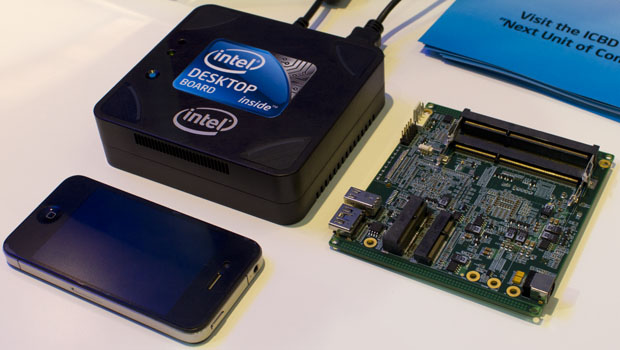
Intel has again showed their company’s mini system called Intel NUC. The device is only 4” by 4” in size and that’s about 98 millimeters by 98 for European miniPC fans.
We’ve just presented VIA’s ARTiGO 1200 and the differences are considerable.
To our surprise, besides the cheap and dull design, NUC doesn’t bring any innovative useful features.
There’s no USB 3.0, there is no card reader and optical unit. There are no original features and no productivity or specialized additions either.
When talking about mini systems, productivity and versatility is are most important issues.
The system can only be this small and if the company’s goal is not to make a USB stick-sized device, we can’t see the difference in “smallness” between a 4” by 4” device with no versatility and a 7” by 7” device like MacMini.
VIA’s ARTiGO and Apple’s MacMini are bringing extended connectivity options, better build quality and much pleasant design with an overall versatility that should be envied by Intel’s NUC.
We would have liked to see an optical unit on NUC as we are completely against the trend of not really owning what you buy.
Storing media and data online is a useful idea for the ones on the go that want to have a centralized data storage unit, but not acceptable for movie and music collectors.
There are users that like to really own the media they buy.
A receipt allowing them to view it online when they are online or if they are able to connect to the server holding the file is not satisfactory nor a desired type of ownership.
The company should understand that without a special feature such a dual LAN, multiple USB connectors (six or eight), an optical drive, card reader and DVI along with miniDP and VGA we have almost no reason to consider buying it.
The one side where Intel’s NUC excels is performance. The i5 Core CPU is considerable more powerful than VIA’s Eden X2 and there are decent upgrade option such as a pail of SO-DIMM slots two miniPCIe expansions.
On the other hand, if we would be searching for performance we wouldn’t search for it in a mini system.
Besides the mandatory optical drive with slot loading that should not be missing from absolutely any PC system larger than a smartphone, we would like to see a card reader and six to eight USB 3.0 slots in any such device.
Diverse connectivity options like VGA, HDMI, DL-DVI, miniDP, eSATA, Thrunderbolt and WiDi should be present in all such devices.
So should be wireless connectivity with internal antennas and external connectors with concealing caps for bigger 10 dBi antennas.
After all of these, there should be different options to differentiate the product line such as multiple SO-DIMM slots, multiple (usually two) 2.5” HDD bays, dual LANs etc.
Accessories can also further differentiate this type of systems.
Some accessories like an external graphics card such as MSI’s GUS II or SONY’s external drive featured in the VAIO Z line would be great and innovative products.
A small battery pack to use the system as a wireless external HDD just like Patriot’s Gauntlet or IO Data’s new WirelessHDD should also be an option for the user to pay extra for.
On the 3D side, the ones interested in a little gaming on a SFF system will clearly go for AMD's Trinity or Brazos 2.0 that offer three to ten times the performance of Intel's HD3000.
Lacking innovative features, versatility, being handicapped on connectivity and bringing nothing original we have a hard time choosing it over mini systems based on AMD’s Brazos or somewhat larger SFFs such as MacMini or VIA ARTiGO.
Any user interested in versatility, gaming power, low power consumption, respectable design and a lower price will steer clear of Intel’s 400 USD NUC.
That’s about 320 EUR for the European “mini” fans.
With less gaming power than any miniPC based on AMD's Brazos 2.0 or Trinity, less connectivity, higher power consumption, less performance than MacMini, lacking design and innovative features, Intel's NUC is just a display of technological capability.
Via: Intels NUC: A Handicapped MacMini Lacking Innovativity
Tidak ada komentar:
Posting Komentar